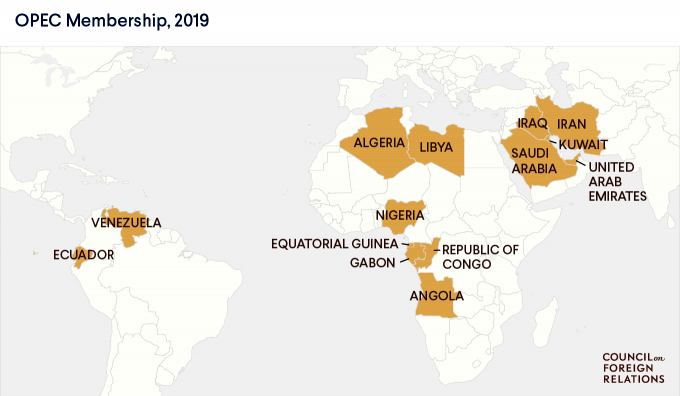Global Energy Transition | 09 Dec 2020
This article is based on “India’s evolving energy diplomacy” which was published in The Hindustan Times on 07/12/2020. It talks about the transition in global energy geopolitics and the challenges emanating from it.
Recently, the Organisation of Petroleum Exporting Countries (OPEC) decided to allow an increase in production of crude oil. This would mean cheaper oil, which may result in profits for oil-importing countries like India.
However, the global energy system is undergoing a transition away from nearly complete dependence on fossil fuels toward a greater reliance on clean and renewable energy sources.
As the global low-carbon energy transition impacts the geopolitics of energy, India's energy diplomacy should not be just about cheaper oil. It should focus on a long-term policy that fulfils India’s energy needs while adhering to the commitment of a clean environment.
In this context, bilateral energy diplomacy is a critical foreign policy tool to manage the geopolitical consequences of the low-carbon energy transition.
Global Energy Geopolitics Transition
- Oil Becoming Epicentre of Global Geopolitics: The shifting of energy source from coal supplies to oil supplies has led to the Middle East becoming an essential epicentre of global geopolitics and to oil becoming a vital issue for national security.
- Since the second half of the 20th century, control of oil resources has played a central role in several wars, such as the Iran-Iraq War (1980-1988), the Gulf War (1990-1991), etc.
- Global Warming & Global Concern: The global concern for more than half a century oil and natural gas have been at the heart of the geopolitics of energy. However, the over-dependence on oil & gas has brought the global issue of global warming into the forefront.
- Many important events like the Kyoto Protocol signing & Paris Agreement marked the critical steps forward in global efforts to respond to the challenge of global warming.
- Decarbonisation Process Getting Strengthened: Under the Paris Agreement, the countries have committed themselves to act to limit the increase in the average global temperature to well below 2°C compared to pre-industrial levels.
- This reinforces the decarbonisation measures already in place in several parts of the world.
- Meanwhile, technological advances have increased the competitiveness of solar and wind energy technologies, batteries and electric cars.
- The convergence of these two elements has started to reshape the global energy system. This can be seen from India establishing the International Solar Alliance.
Challenges of Global Energy Transition
- Challenge For Oil Producing Countries: The global energy transition represents a challenge for oil- and gas-producing countries, and in particular for those with a less diversified economy more dependent on oil revenues.
- If the global energy transition were to take place more quickly than expected, and if these countries were to remain unprepared, the consequences could be serious from both the socio-economic and geopolitical points of view.
- Threats Emanating From Energy Integration: The spread of renewable energies will increase electrification and stimulate cross-border trade in electricity. For example, India’s call to establish “one sun one world one grid system (OSOWOG)”.
- The digitisation of electricity grids presents security risks, as terrorist groups or hostile countries could seek to either enter the systems to extrapolate information, or to disrupt them to cause economic and social damages.
- Supply of Rare-Earth Mineral: The rapid development of wind and solar energy, together with that of electric cars, raises concerns about the security of supply of the minerals needed to manufacture them.
- The dominance of China in the supply of these rare minerals and current geopolitical tension between US & China could trigger a case like the ‘cobalt crisis’ of 1978.
Note: Cobalt Crisis
- The ‘cobalt crisis’ of 1978, following the outbreak of a conflict in the province of Katanga – the heart of world mineral extraction – in what was then called Zaire.
- The crisis caused a global shortage of cobalt, driving the international price of the mineral to the sky.
What Should India Do?
The real challenge for India’s energy diplomacy is preparing the ground for a post-oil future in a manner that ensures oil markets abet rather than disrupt this larger transition. In this context, India energy diplomacy should focus on both the fossil fuel & renewable energy axis.
- On the Fossil Fuel Axis: The government should leverage its buyer strength to secure “most favoured” terms of trade for crude supplies.
- In this regard, India can negotiate with major oil & gas producing countries to enter into long term agreement, citing the onset of peak oil demand in India and the decline of oil demand in the developed world.
- On the Renewable Axis: India must develop its own world-scale, competitive, manufacturing systems for Renewable energy. In this context:
- First, India will need to build solar and wind power at an unprecedented scale and speed, replacing coal-fired power plants.
- Second, India will need to extend the reach of that renewable energy to power sectors of the economy like industry and transportation that haven't traditionally used electricity.
- Third, India must become radically more energy-efficient.
Conclusion
Some many opportunities and challenges are emanating from the global energy transition. However, from the Indian perspective, thanks to record foreign exchange reserves, India today can absorb somewhat higher global oil prices, and shift focus on attracting the massive investments needed for its natural gas and renewable energy plans.
|
Drishti Mains Question Energy diplomacy is a critical foreign policy tool to manage 21st-century bilateral relations. Discuss. |
This editorial is based on “Fighting Malnutrition: Govt must focus on nutrient security” which was published in The Financial Express on December 8th, 2020. Now watch this on our Youtube channel.

